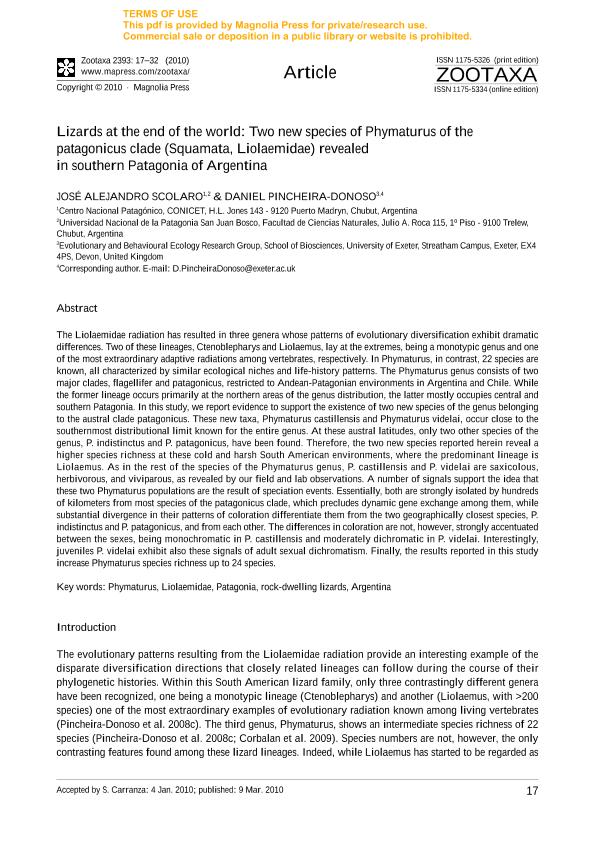Artículo
Lizards at the end of the world: two new species of Phymaturus of the patagonicus clade (Squamata, Liolaemidae) revealed in southern Patagonia of Argentina
Fecha de publicación:
01/2010
Editorial:
Magnolia Press
Revista:
Zootaxa
ISSN:
1175-5326
e-ISSN:
1175-5334
Idioma:
Inglés
Tipo de recurso:
Artículo publicado
Clasificación temática:
Resumen
The Liolaemidae radiation has resulted in three genera whose patterns of evolutionary diversification exhibit dramatic differences. Two of these lineages, Ctenoblepharys and Liolaemus, lay at the extremes, being a monotypic genus and one of the most extraordinary adaptive radiations among vertebrates, respectively. In Phymaturus, in contrast, 22 species are known, all characterized by similar ecological niches and life-history patterns. The Phymaturus genus consists of two major clades, flagellifer and patagonicus, restricted to Andean-Patagonian environments in Argentina and Chile. While the former lineage occurs primarily at the northern areas of the genus distribution, the latter mostly occupies central and southern Patagonia. In this study, we report evidence to support the existence of two new species of the genus belonging to the austral clade patagonicus. These new taxa, Phymaturus castillensis and Phymaturus videlai, occur close to the southernmost distributional limit known for the entire genus. At these austral latitudes, only two other species of the genus, P. indistinctus and P. patagonicus, have been found. Therefore, the two new species reported herein reveal a higher species richness at these cold and harsh South American environments, where the predominant lineage is Liolaemus. As in the rest of the species of the Phymaturus genus, P. castillensis and P. videlai are saxicolous, herbivorous, and viviparous, as revealed by our field and lab observations. A number of signals support the idea that these two Phymaturus populations are the result of speciation events. Essentially, both are strongly isolated by hundreds of kilometers from most species of the patagonicus clade, which precludes dynamic gene exchange among them, while substantial divergence in their patterns of coloration differentiate them from the two geographically closest species, P. indistinctus and P. patagonicus, and from each other. The differences in coloration are not, however, strongly accentuated between the sexes, being monochromatic in P. castillensis and moderately dichromatic in P. videlai. Interestingly, juveniles P. videlai exhibit also these signals of adult sexual dichromatism. Finally, the results reported in this study increase Phymaturus species richness up to 24 species.
Palabras clave:
Phymaturus
,
Liolaemidae
,
Patagonia
,
Rock-Dwelling Lizards
,
Argentina
Archivos asociados
Licencia
Identificadores
Colecciones
Articulos(CCT-CENPAT)
Articulos de CTRO.CIENTIFICO TECNOL.CONICET - CENPAT
Articulos de CTRO.CIENTIFICO TECNOL.CONICET - CENPAT
Citación
Scolaro, Jose Alejandro; Pincheira Donoso, Daniel; Lizards at the end of the world: two new species of Phymaturus of the patagonicus clade (Squamata, Liolaemidae) revealed in southern Patagonia of Argentina; Magnolia Press; Zootaxa; 2393; 1-2010; 17-32
Compartir




